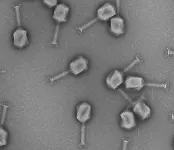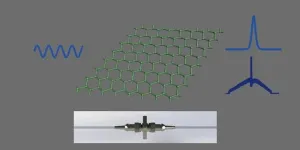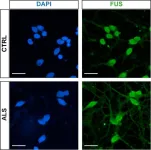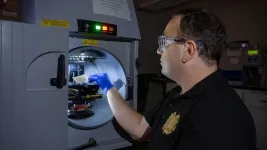(Press-News.org) About one in two women are affected by cystitis during her lifetime, and many suffer from recurrent urinary tract infections. Bladder infections are not only painful and potentially dangerous, but they also pose a significant dilemma for physicians. With antibiotic resistance becoming widespread in urinary tract infections and continually increasing, physicians are often forced to blindly prescribe antibiotics without knowing their effectiveness against the pathogen causing the infection. This is because it takes several days to identify a specific pathogen using conventional diagnostics.
Researchers at ETH Zurich, in collaboration with Balgrist University Hospital, have now developed a rapid test that employs the natural viral predators of bacteria, bacteriophages. The researchers also genetically modified the phages to make them more efficient at destroying the pathogenic bacteria.
Fast and reliable diagnosis
Phages are highly specialised viruses. Each species of phage infects only one particular type or strain of bacteria. ETH Zurich scientists from the Food Microbiology research group led by Professor Martin Loessner are now taking advantage of this unique characteristic. The first step was to identify the phages that are effective against the three main types of bacteria implicated in urinary tract infections, namely Escherichia coli, Klebsiella and Enterococci. These natural phages were then modified in such a way that any bacteria they recognize and infect are propelled to produce an easy-to-measure light signal.
Using this method, the researchers were able to reliably detect the pathogenic bacteria directly from a urine sample in less than four hours. In the future, the method could make it possible to prescribe a suitable antibiotic immediately after diagnosis and thus minimize resistance development and improve antibiotic stewardship.
The method also has another advantage: it allows physicians to predict which patients are likely to respond particularly well to a tailored phage therapy, as the strength of the light signal produced in the assay already indicates how efficient the phages are in attacking the bacterium – the more the sample glows, the better the bacterium will respond to the therapy.
Double-action sniper
Phage therapies have been used for over 100 years but fell into oblivion in Western industrialised countries with the discovery of penicillin. In view of increasing antibiotic resistance, they are currently seeing a renaissance. They also have the decisive advantage of attacking only a single target bacterium, much like a sniper.
However, previous therapeutic approaches have one problem: “Phages aren’t interested in completely killing their host, the pathogenic bacterium,” explains ETH researcher Samuel Kilcher, one of the study’s two final authors. To enhance the phages’ effectiveness, the researchers genetically modified them. The modified phages produce not only new phages inside the infected host bacterium, but also bacteriocins. Once they are released, these bacteria-killing proteins are particularly effective against bacterial strains that have altered parts of their surface in such a way that the phages no longer recognise them. This double-barrelled attack makes the treatment more effective.
From the laboratory to the clinic
In individual cases, such as the recent rescue of a lung patient at the University Hospital of Geneva, phage therapies have been successfully used experimentally. “There are also many academic and commercial clinical trials underway worldwide that are systematically investigating the potential of natural and genetically optimized phages,” says Matthew Dunne, one of the study's final authors. However, there is a long way to go before such therapies can be applied more widely in Western countries. In addition to extensive clinical studies, regulatory adjustments would also be useful, taking into account the fact that phages are biological entities that co-evolve with their bacterial hosts, i.e., they are constantly evolving.
The present study is a proof of concept. Next, the ETH Zurich researchers, together with their partners from Balgrist University Hospital, will test the efficacy of the new phage therapy in a clinical trial with selected patients.
END
Treating bladder infections with viruses
2023-07-21
ELSE PRESS RELEASES FROM THIS DATE:
Two types of ultrafast mode-locking operations generation from an Er-doped fiber laser based on germanene nanosheets
2023-07-21
Saturable absorbers as passive modulators in passively mode-locked fiber lasers play a crucial role in the generation of ultrashort pulses. Germanene, a graphene-like two-dimensional material with fast carrier relaxation time and large nonlinear absorption coefficient comparable to that of graphene, is a saturable absorber material with very fast response.
Researchers led by Prof. Wei Xia at University of Jinan (UJN), are interested in modulation switches in fiber lasers, and two-dimensional material saturable absorbers have been a hot research topic in recent years. Two-dimensional materials make up for the disadvantages of ...
Trends in the prevalence of hepatitis C infection during pregnancy and maternal-infant outcomeTrends in the prevalence of hepatitis C infection during pregnancy and maternal-infant outcomes
2023-07-21
About The Study: This study of more than 70 million births or spontaneous abortions showed the prevalence of hepatitis C (HCV)-positive pregnancies in the U.S. increased 16-fold between 1998 and 2018. Maternal HCV infection was associated with increased odds of preterm labor, poor fetal growth, or fetal distress. These data may support recent recommendations for universal HCV screening with each pregnancy.
Authors: Po-Hung Chen, M.D., Ph.D., of the Johns Hopkins University School of Medicine in Baltimore, ...
Association between cervical cancer screening guidelines and preterm delivery
2023-07-21
About The Study: The findings of this study of births to females ages 18 to 24 suggest that additional recommended cervical cancer screenings before birth were associated with an increased risk of preterm delivery. Cervical cancer screening guidelines should consider the downstream implications for preterm delivery risk when weighing the population-level costs of screenings against the benefits of reduced cervical cancer mortality.
Authors: Rebecca Bromley-Dulfano, M.S., of Harvard University Medical School in Cambridge, Massachusetts, is the corresponding author.
To ...
Research reveals the scale of disorder underpinning Motor Neurone Disease
2023-07-21
Francis Crick Institute press release
Under strict embargo: 16:00hrs BST 21 July 2023
Peer reviewed
Experimental study
Cells
Research reveals the scale of disorder underpinning Motor Neurone Disease
Researchers at the Francis Crick Institute and UCL have shown that hundreds of proteins and mRNA molecules are found in the wrong place in nerve cells affected by Motor Neuron Disease (MND), also known as Amyotrophic Lateral Sclerosis (ALS).
ALS is a rapidly progressing and devastating condition that causes paralysis by affecting ...
Scripps Research scientists develop AI-based tracking and early-warning system for viral pandemics
2023-07-21
LA JOLLA, CA — Scripps Research scientists have developed a machine-learning system—a type of artificial intelligence (AI) application—that can track the detailed evolution of epidemic viruses and predict the emergence of viral variants with important new properties.
In a paper in Cell Patterns on July 21, 2023, the scientists demonstrated the system by using data on recorded SARS-CoV-2 variants and COVID-19 mortality rates. They showed that the system could have predicted the emergence of new SARS-CoV-2 “variants of concern” (VOCs) ahead of their official designations by the World Health Organization (WHO). Their ...
University of Liverpool scientists make promising discovery in fight against breast cancer
2023-07-21
Researchers from the University of Liverpool have created a biomedical compound that has the potential to stop the spread of breast cancer. A recently published paper details these early findings.
Scientists from the Chemistry and Biochemistry Departments at the University of Liverpool and Nanjing Medical School in China have discovered a possible way to block proteins produced in the body when a patient has cancer and which causes its spread to other parts of the body. This process, called metastasis, is largely responsible for patient deaths.
The major problem hindering the successful treatment of commonly occurring cancers is not the primary tumour which can usually be removed by ...
Male crickets court females in unison – unless rivals get too close
2023-07-21
Male crickets sing in unison to attract females – but stop singing if a rival gets too close, new research shows.
University of Exeter scientists watched more than 100 male field crickets, and measured how often they chirped at the same time (called “singing overlap”).
Singing by males one to five metres away from a listening male had a “stimulatory effect”, leading to a chorus of crickets singing together.
However, males were less likely to sing if another cricket chirped within one metre – possibly because the territorial insects instead chose to fight ...
Some people’s brain function still affected by Long COVID years after infection
2023-07-21
Some people’s brain function still affected by Long COVID years after infection
UK researchers have found that people with longer-term COVID-19 symptoms including brain fog showed reduced performance in tasks testing different mental processes up to two years after infection with the virus.
Researchers from King’s College London looked at whether infection with COVID-19 affected performance in two rounds of online cognitive testing that took place in 2021 and 2022. Data was collected for over 3,000 participants of the COVID Symptom Study Biobank study, across 12 tasks that tested memory, attention, reasoning, processing speed and ...
MASER technology scientist awarded funding for new research
2023-07-21
A scientist from Northumbria University has been awarded almost half a million pounds to develop a new technology which could transform deep-space communication, radio astronomy, medical imaging and airport security scanning.
Dr Juna Sathian has received a grant from the government’s Engineering & Physical Sciences Research Council (EPSRC) to develop a new type of MASER (Microwave Amplification by Stimulated Emission of Radiation) device.
The forerunner to LASERs, MASERs were first discovered in the 1950s. But there has been ...
Researchers decipher the secrets of Benjamin Franklin’s paper money
2023-07-21
Benjamin Franklin may be best known as the creator of bifocals and the lightning rod, but a group of University of Notre Dame researchers suggest he should also be known for his innovative ways of making (literal) money.
During his career, Franklin printed nearly 2,500,000 money notes for the American Colonies using what the researchers have identified as highly original techniques, as reported in a study published this week in the Proceedings of the National Academy of Sciences.
The research team, led by Khachatur Manukyan, an associate research professor ...




